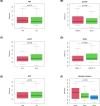An angiogenesis-related long noncoding RNA signature correlates with prognosis in patients with hepatocellular carcinoma
- PMID: 33764367
- PMCID: PMC8026853
- DOI: 10.1042/BSR20204442
An angiogenesis-related long noncoding RNA signature correlates with prognosis in patients with hepatocellular carcinoma
Abstract
Hepatocellular carcinoma (HCC) is one of the most prevalent and lethal cancers worldwide. Neovascularization is closely related to the malignancy of tumors. We constructed a signature of angiogenesis-related long noncoding RNA (lncRNA) to predict the prognosis of patients with HCC. The lncRNA expression matrix of 424 HCC patients was downloaded from The Cancer Genome Atlas (TCGA). First, gene set enrichment analysis (GSEA) was used to distinguish the differentially expressed genes of the angiogenesis genes in liver cancer and adjacent tissues. Next, a signature of angiogenesis-related lncRNAs was constructed using univariate and multivariate analyses, and receiver operating characteristic (ROC) curves were used to assess the accuracy. The signature and relevant clinical information were used to construct the nomogram. A 5-lncRNA signature was highly correlated with overall survival (OS) in HCC patients and performed well in evaluations using the C-index, areas under the curve, and calibration curves. In summary, the 5-lncRNA model can serve as an accurate signature to predict the prognosis of patients with liver cancer, but its mechanism of action must be further elucidated by experiments.
Keywords: GSEA; angiogenesis; mRNA signature.
© 2021 The Author(s).
Conflict of interest statement
The authors declare that there are no competing interests associated with the manuscript.
Figures








Similar articles
-
Six-long non-coding RNA signature predicts recurrence-free survival in hepatocellular carcinoma.World J Gastroenterol. 2019 Jan 14;25(2):220-232. doi: 10.3748/wjg.v25.i2.220. World J Gastroenterol. 2019. PMID: 30670911 Free PMC article.
-
A novel seven-lncRNA signature for prognosis prediction in hepatocellular carcinoma.J Cell Biochem. 2019 Jan;120(1):213-223. doi: 10.1002/jcb.27321. Epub 2018 Sep 11. J Cell Biochem. 2019. PMID: 30206981
-
15-lncRNA-Based Classifier-Clinicopathologic Nomogram Improves the Prediction of Recurrence in Patients with Hepatocellular Carcinoma.Dis Markers. 2020 Dec 1;2020:9180732. doi: 10.1155/2020/9180732. eCollection 2020. Dis Markers. 2020. PMID: 33520012 Free PMC article.
-
Reconstruction and Analysis of the Differentially Expressed IncRNA-miRNA-mRNA Network Based on Competitive Endogenous RNA in Hepatocellular Carcinoma.Crit Rev Eukaryot Gene Expr. 2019;29(6):539-549. doi: 10.1615/CritRevEukaryotGeneExpr.2019028740. Crit Rev Eukaryot Gene Expr. 2019. PMID: 32422009 Review.
-
LncRNA as a Therapeutic Target for Angiogenesis.Curr Top Med Chem. 2017;17(15):1750-1757. doi: 10.2174/1568026617666161116144744. Curr Top Med Chem. 2017. PMID: 27848894 Free PMC article. Review.
Cited by
-
Construction and validation of an angiogenesis-related lncRNA prognostic model in lung adenocarcinoma.Front Genet. 2023 Mar 14;14:1083593. doi: 10.3389/fgene.2023.1083593. eCollection 2023. Front Genet. 2023. PMID: 36999053 Free PMC article.
-
Identification and validation of a novel angiogenesis-related gene signature for predicting prognosis in gastric adenocarcinoma.Front Oncol. 2023 Jan 16;12:965102. doi: 10.3389/fonc.2022.965102. eCollection 2022. Front Oncol. 2023. PMID: 36727080 Free PMC article.
-
The Pyroptosis-Related Long Noncoding RNA Signature Predicts Prognosis and Indicates Immunotherapeutic Efficiency in Hepatocellular Carcinoma.Front Cell Dev Biol. 2022 May 26;10:779269. doi: 10.3389/fcell.2022.779269. eCollection 2022. Front Cell Dev Biol. 2022. PMID: 35712653 Free PMC article.
-
Role of angiogenesis-related lncRNAs in tumor microenvironment and prognosis of lung adenocarcinoma.Genes Dis. 2025 Jun 11;12(6):101700. doi: 10.1016/j.gendis.2025.101700. eCollection 2025 Nov. Genes Dis. 2025. PMID: 40697994 Free PMC article. No abstract available.
-
Angiogenesis-related lncRNAs predict the prognosis signature of stomach adenocarcinoma.BMC Cancer. 2021 Dec 7;21(1):1312. doi: 10.1186/s12885-021-08987-y. BMC Cancer. 2021. PMID: 34876056 Free PMC article.
References
Publication types
MeSH terms
Substances
LinkOut - more resources
Full Text Sources
Other Literature Sources
Medical

